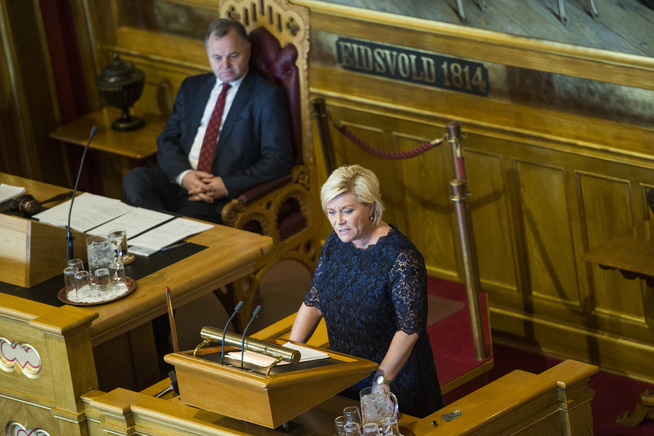the Return on the Norwegian people’s savings, managed through its oil wealth, can be as low as 2.3 per cent per year through the next three decades, according to a regjeringsoppnevnt selection.
It is close to a halving of the Parliament expected in 2001, when the determined fiscal rule that sets a ceiling on the government’s use of oljepenger.
– the Estimate for the real return of the Government pension fund global must be significantly lower than the four per cent, ” says committee chairman Knut Anton Mork, professor II at NTNU, to E24.
After eight months of work, presented the Mark-selection on Tuesday its report to finance minister Siv Jensen.
Selection proposes that, among other things, to increase the fund’s stake in the hope of higher returns, but warns at the same time that this will make the fund more susceptible to sudden impairment, which can be difficult for the future governments.

Variety asks its oil wealth to buy more shares
Challenging fiscal policies
the Mark-the committee’s task was to evaluate oljefondets stake, but its estimates of the fund’s performance may play into the ongoing debate about the government’s use of oljepenger, which has never been higher, measured against the size of the Norwegian economy.
the Committee is asking future governments to be careful with the phasing in of oljepenger, not to prey at fortune.
It will be more challenging to practice fiscal forward, enter selection.
“theGovernment pension fund global” is the world’s largest state verdifond. The fund goes in the vernacular under the name ” its oil wealth“.
Is at around 7100 billion, and has investments in over 9,000 companies and 78 countries.
the Money deposited in the fund, the Norwegian government revenue from the oil and gas sector, as well as the return on the positions of the fund’s assets.
the Money that goes out of the fund, is an annual transfer to the treasury to the use of the state budget.
Mark-selection prompts among other things, the government to consider a long time to increase the oljepengebruken in periods when the fund rises in value, but a shorter time to reduce use during periods when the fund’s value fall.
Femdoblet in ten years
the Government has proposed to use 225,6 billion oljekroner in next year’s budget, a femdobling of the level ten years earlier. Use the equivalent of three per cent of the fund’s value, against 2.5 per cent in 2007.
– We’ve put behind us 15 years with a strong increase in the transfers, and then it’s over, ” says utvalgsmedlem Harald Magnus Andreassen to E24.
– But it’s no disaster, we must not cut, we must not tighten. We just can’t get as much extra money as we have been accustomed to having in 15 years.
finance minister Siv Jensen says that she is going to see the input from the Mark-selection in the context of the report from Thøgersen-selection, as in June last year, advocated to limit the withdrawal from the fund to avoid significant innstramminger in the future.
– We will come with our recommendations overall, in the course of the spring, ” says Jensen.

The government will evaluate the management of oljepengene to spring
use less
– This is probably a regjeringsoppnevnt ekspertutvalg which in any case are indirectly saying that the current handlingsregel and the current practice of the fiscal rule cannot continue, ” says Terje Breivik, deputy chairman of the government’s støtteparti the Left, to E24.
the Fiscal rule says that the government can use a certain percentage of the fund’s value in their annual budgets, a value that until now has been estimated to be four per cent. Breivik believes it would be reasonable to reduce the percentage to three percent, something the governor Øystein Olsen suggested already four years ago.

Harald Magnus Andreassen, chief economist of Swedbank
Mark-selection main conclusion is that the share portion of its oil wealth should be increased to 70 per cent, against the current 60 per cent, which could increase the annual yield by 15 to 30 billion. The return would decrease correspondingly in the case of a reduction in the share portion to 50 per cent, says the committee.
committee chairman Mark is the only one in the selection who want a reduction to 50 per cent of shares, which he justifies with a need for low risk and predictability.
– to put it a little bit on the tip, so I do not want a situation where state aid to the summer festivals are being cut because it goes bad in the stock market, ” says Mark.
Increased risk
Increased stake provides an increased risk for large falls in the fund’s value, but this is acceptable given that the Parliament and the government have the will and ability to adapt its policies, says the selection, and thus suggests that the government should go more slowly forward with the phasing in of oljepenger.
This is the committee’s estimate ovis oljefondets returns by various aksjeandeler:
50 percent of shares: 2 per cent annual rate of return
60 percent of shares: 2.3% annual rate of return
70 per cent shares: 2.6 per cent annual rate of return

Predecessors provides Siv Jensen aksjeråd for its oil wealth
Low interest rates destroy
There is a particularly low return on fixed income instruments that will drag down the fund’s earnings forecast, while shares provide a higher return. Selection expect around 0.5 per cent annual return on securities, against 2.7 per cent that was added because when Parliament last reviewed the fund’s stake in 2007.
Mark-selection expect that the shares will plunge of around three per cent more per year over and above the return on bonds, which is approximately in line with the estimates in 2007.
the Committee has considered the aksjeandeler from 40 percent and up to 80 percent. The fund is currently invested 60 percent in stocks, 35 percent in bonds and up to five percent property.
No comments:
Post a Comment